Case Study of Doug Elliot: Legal and Ethical Considerations in Nursing Care
VerifiedAdded on 2023/06/18
|10
|3770
|172
AI Summary
This essay discusses the case study of Doug Elliot, a patient with bowel cancer, and focuses on legal and ethical considerations in nursing care. It explains the clinical reasoning cycle and its application in developing an effective care plan for the patient. The essay also identifies the impact of hospitalization, personal and professional values, and considerations for patient discharge.
Contribute Materials
Your contribution can guide someone’s learning journey. Share your
documents today.
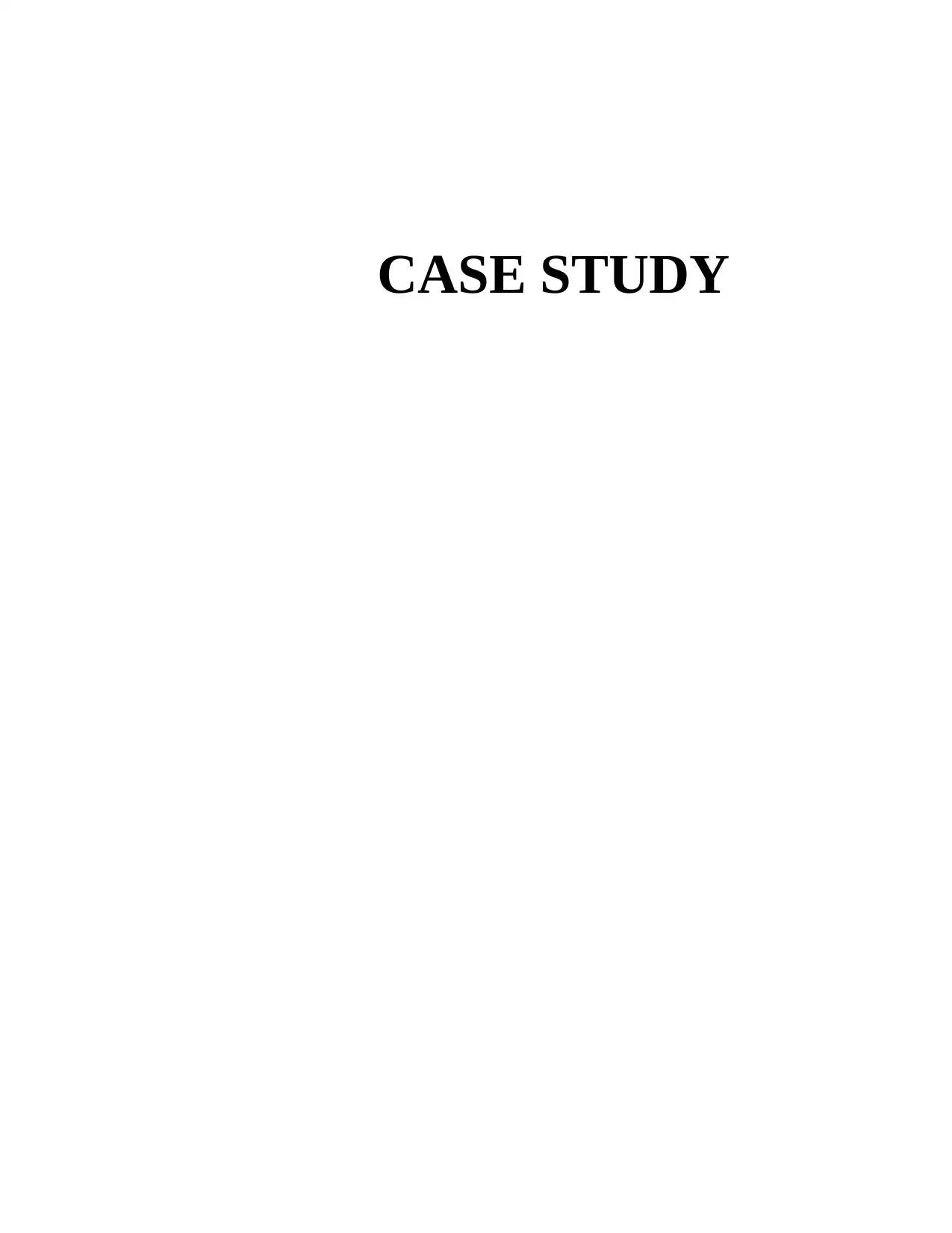
CASE STUDY
Secure Best Marks with AI Grader
Need help grading? Try our AI Grader for instant feedback on your assignments.
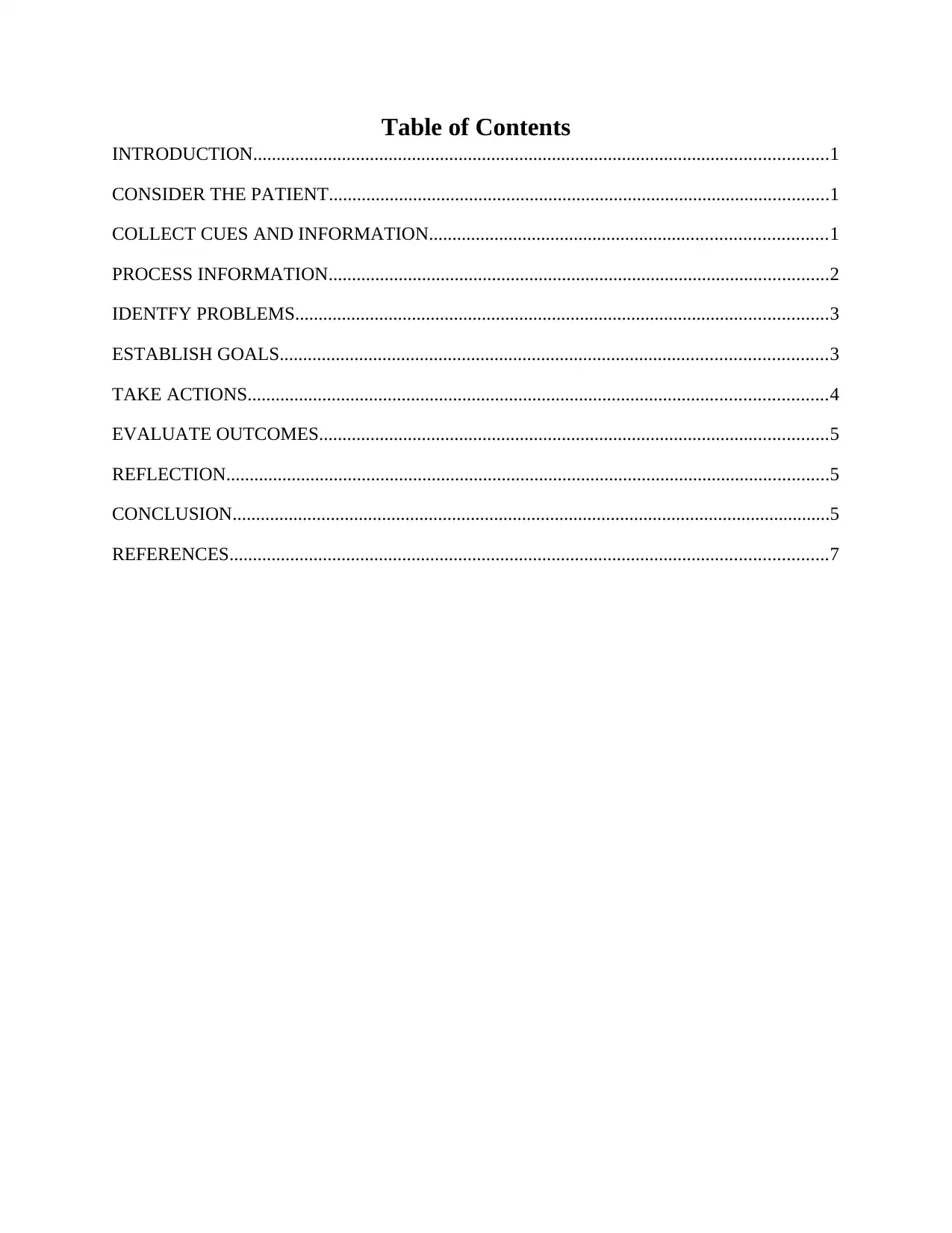
Table of Contents
INTRODUCTION...........................................................................................................................1
CONSIDER THE PATIENT...........................................................................................................1
COLLECT CUES AND INFORMATION.....................................................................................1
PROCESS INFORMATION...........................................................................................................2
IDENTFY PROBLEMS..................................................................................................................3
ESTABLISH GOALS.....................................................................................................................3
TAKE ACTIONS............................................................................................................................4
EVALUATE OUTCOMES.............................................................................................................5
REFLECTION.................................................................................................................................5
CONCLUSION................................................................................................................................5
REFERENCES................................................................................................................................7
INTRODUCTION...........................................................................................................................1
CONSIDER THE PATIENT...........................................................................................................1
COLLECT CUES AND INFORMATION.....................................................................................1
PROCESS INFORMATION...........................................................................................................2
IDENTFY PROBLEMS..................................................................................................................3
ESTABLISH GOALS.....................................................................................................................3
TAKE ACTIONS............................................................................................................................4
EVALUATE OUTCOMES.............................................................................................................5
REFLECTION.................................................................................................................................5
CONCLUSION................................................................................................................................5
REFERENCES................................................................................................................................7
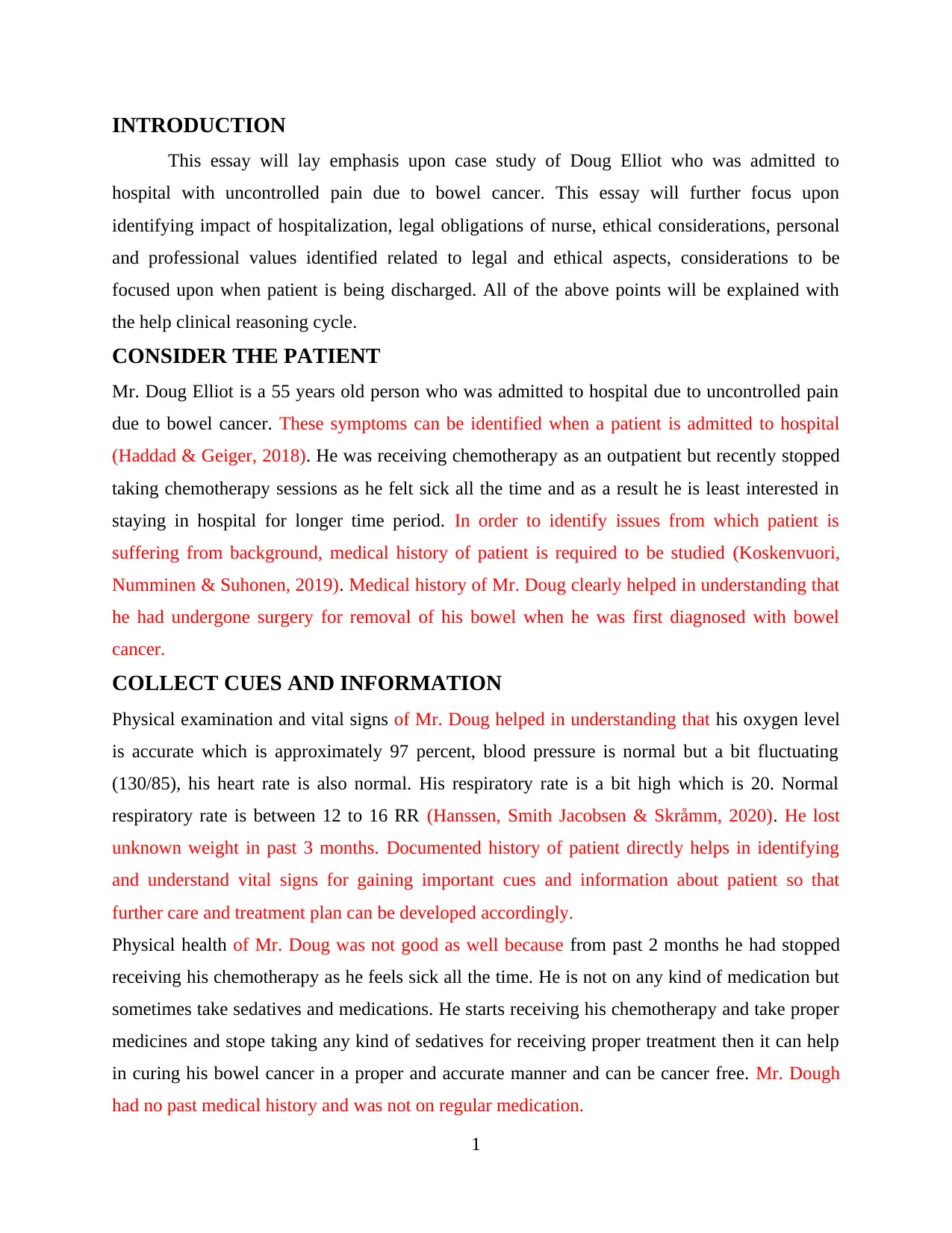
INTRODUCTION
This essay will lay emphasis upon case study of Doug Elliot who was admitted to
hospital with uncontrolled pain due to bowel cancer. This essay will further focus upon
identifying impact of hospitalization, legal obligations of nurse, ethical considerations, personal
and professional values identified related to legal and ethical aspects, considerations to be
focused upon when patient is being discharged. All of the above points will be explained with
the help clinical reasoning cycle.
CONSIDER THE PATIENT
Mr. Doug Elliot is a 55 years old person who was admitted to hospital due to uncontrolled pain
due to bowel cancer. These symptoms can be identified when a patient is admitted to hospital
(Haddad & Geiger, 2018). He was receiving chemotherapy as an outpatient but recently stopped
taking chemotherapy sessions as he felt sick all the time and as a result he is least interested in
staying in hospital for longer time period. In order to identify issues from which patient is
suffering from background, medical history of patient is required to be studied (Koskenvuori,
Numminen & Suhonen, 2019). Medical history of Mr. Doug clearly helped in understanding that
he had undergone surgery for removal of his bowel when he was first diagnosed with bowel
cancer.
COLLECT CUES AND INFORMATION
Physical examination and vital signs of Mr. Doug helped in understanding that his oxygen level
is accurate which is approximately 97 percent, blood pressure is normal but a bit fluctuating
(130/85), his heart rate is also normal. His respiratory rate is a bit high which is 20. Normal
respiratory rate is between 12 to 16 RR (Hanssen, Smith Jacobsen & Skråmm, 2020). He lost
unknown weight in past 3 months. Documented history of patient directly helps in identifying
and understand vital signs for gaining important cues and information about patient so that
further care and treatment plan can be developed accordingly.
Physical health of Mr. Doug was not good as well because from past 2 months he had stopped
receiving his chemotherapy as he feels sick all the time. He is not on any kind of medication but
sometimes take sedatives and medications. He starts receiving his chemotherapy and take proper
medicines and stope taking any kind of sedatives for receiving proper treatment then it can help
in curing his bowel cancer in a proper and accurate manner and can be cancer free. Mr. Dough
had no past medical history and was not on regular medication.
1
This essay will lay emphasis upon case study of Doug Elliot who was admitted to
hospital with uncontrolled pain due to bowel cancer. This essay will further focus upon
identifying impact of hospitalization, legal obligations of nurse, ethical considerations, personal
and professional values identified related to legal and ethical aspects, considerations to be
focused upon when patient is being discharged. All of the above points will be explained with
the help clinical reasoning cycle.
CONSIDER THE PATIENT
Mr. Doug Elliot is a 55 years old person who was admitted to hospital due to uncontrolled pain
due to bowel cancer. These symptoms can be identified when a patient is admitted to hospital
(Haddad & Geiger, 2018). He was receiving chemotherapy as an outpatient but recently stopped
taking chemotherapy sessions as he felt sick all the time and as a result he is least interested in
staying in hospital for longer time period. In order to identify issues from which patient is
suffering from background, medical history of patient is required to be studied (Koskenvuori,
Numminen & Suhonen, 2019). Medical history of Mr. Doug clearly helped in understanding that
he had undergone surgery for removal of his bowel when he was first diagnosed with bowel
cancer.
COLLECT CUES AND INFORMATION
Physical examination and vital signs of Mr. Doug helped in understanding that his oxygen level
is accurate which is approximately 97 percent, blood pressure is normal but a bit fluctuating
(130/85), his heart rate is also normal. His respiratory rate is a bit high which is 20. Normal
respiratory rate is between 12 to 16 RR (Hanssen, Smith Jacobsen & Skråmm, 2020). He lost
unknown weight in past 3 months. Documented history of patient directly helps in identifying
and understand vital signs for gaining important cues and information about patient so that
further care and treatment plan can be developed accordingly.
Physical health of Mr. Doug was not good as well because from past 2 months he had stopped
receiving his chemotherapy as he feels sick all the time. He is not on any kind of medication but
sometimes take sedatives and medications. He starts receiving his chemotherapy and take proper
medicines and stope taking any kind of sedatives for receiving proper treatment then it can help
in curing his bowel cancer in a proper and accurate manner and can be cancer free. Mr. Dough
had no past medical history and was not on regular medication.
1
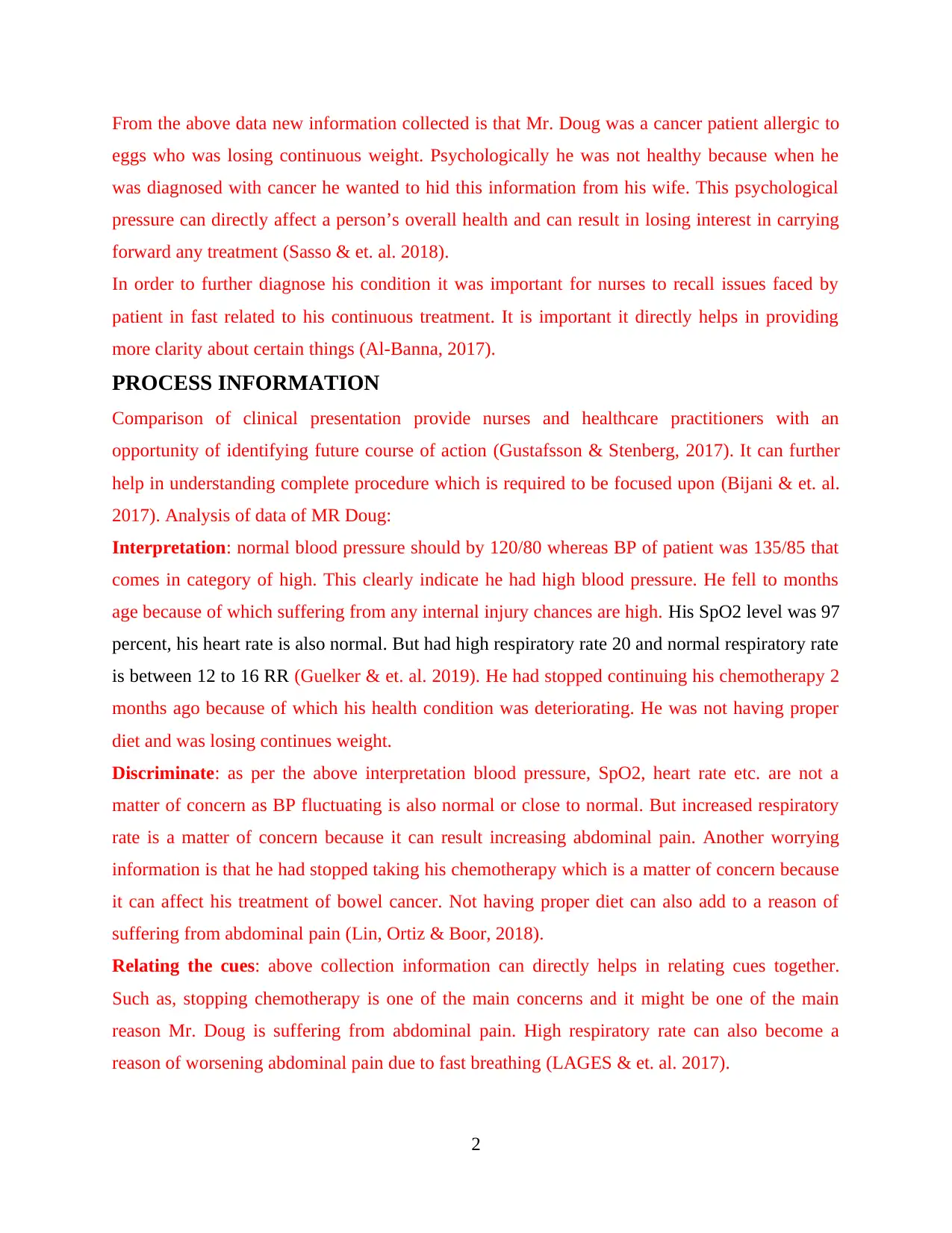
From the above data new information collected is that Mr. Doug was a cancer patient allergic to
eggs who was losing continuous weight. Psychologically he was not healthy because when he
was diagnosed with cancer he wanted to hid this information from his wife. This psychological
pressure can directly affect a person’s overall health and can result in losing interest in carrying
forward any treatment (Sasso & et. al. 2018).
In order to further diagnose his condition it was important for nurses to recall issues faced by
patient in fast related to his continuous treatment. It is important it directly helps in providing
more clarity about certain things (Al-Banna, 2017).
PROCESS INFORMATION
Comparison of clinical presentation provide nurses and healthcare practitioners with an
opportunity of identifying future course of action (Gustafsson & Stenberg, 2017). It can further
help in understanding complete procedure which is required to be focused upon (Bijani & et. al.
2017). Analysis of data of MR Doug:
Interpretation: normal blood pressure should by 120/80 whereas BP of patient was 135/85 that
comes in category of high. This clearly indicate he had high blood pressure. He fell to months
age because of which suffering from any internal injury chances are high. His SpO2 level was 97
percent, his heart rate is also normal. But had high respiratory rate 20 and normal respiratory rate
is between 12 to 16 RR (Guelker & et. al. 2019). He had stopped continuing his chemotherapy 2
months ago because of which his health condition was deteriorating. He was not having proper
diet and was losing continues weight.
Discriminate: as per the above interpretation blood pressure, SpO2, heart rate etc. are not a
matter of concern as BP fluctuating is also normal or close to normal. But increased respiratory
rate is a matter of concern because it can result increasing abdominal pain. Another worrying
information is that he had stopped taking his chemotherapy which is a matter of concern because
it can affect his treatment of bowel cancer. Not having proper diet can also add to a reason of
suffering from abdominal pain (Lin, Ortiz & Boor, 2018).
Relating the cues: above collection information can directly helps in relating cues together.
Such as, stopping chemotherapy is one of the main concerns and it might be one of the main
reason Mr. Doug is suffering from abdominal pain. High respiratory rate can also become a
reason of worsening abdominal pain due to fast breathing (LAGES & et. al. 2017).
2
eggs who was losing continuous weight. Psychologically he was not healthy because when he
was diagnosed with cancer he wanted to hid this information from his wife. This psychological
pressure can directly affect a person’s overall health and can result in losing interest in carrying
forward any treatment (Sasso & et. al. 2018).
In order to further diagnose his condition it was important for nurses to recall issues faced by
patient in fast related to his continuous treatment. It is important it directly helps in providing
more clarity about certain things (Al-Banna, 2017).
PROCESS INFORMATION
Comparison of clinical presentation provide nurses and healthcare practitioners with an
opportunity of identifying future course of action (Gustafsson & Stenberg, 2017). It can further
help in understanding complete procedure which is required to be focused upon (Bijani & et. al.
2017). Analysis of data of MR Doug:
Interpretation: normal blood pressure should by 120/80 whereas BP of patient was 135/85 that
comes in category of high. This clearly indicate he had high blood pressure. He fell to months
age because of which suffering from any internal injury chances are high. His SpO2 level was 97
percent, his heart rate is also normal. But had high respiratory rate 20 and normal respiratory rate
is between 12 to 16 RR (Guelker & et. al. 2019). He had stopped continuing his chemotherapy 2
months ago because of which his health condition was deteriorating. He was not having proper
diet and was losing continues weight.
Discriminate: as per the above interpretation blood pressure, SpO2, heart rate etc. are not a
matter of concern as BP fluctuating is also normal or close to normal. But increased respiratory
rate is a matter of concern because it can result increasing abdominal pain. Another worrying
information is that he had stopped taking his chemotherapy which is a matter of concern because
it can affect his treatment of bowel cancer. Not having proper diet can also add to a reason of
suffering from abdominal pain (Lin, Ortiz & Boor, 2018).
Relating the cues: above collection information can directly helps in relating cues together.
Such as, stopping chemotherapy is one of the main concerns and it might be one of the main
reason Mr. Doug is suffering from abdominal pain. High respiratory rate can also become a
reason of worsening abdominal pain due to fast breathing (LAGES & et. al. 2017).
2
Secure Best Marks with AI Grader
Need help grading? Try our AI Grader for instant feedback on your assignments.
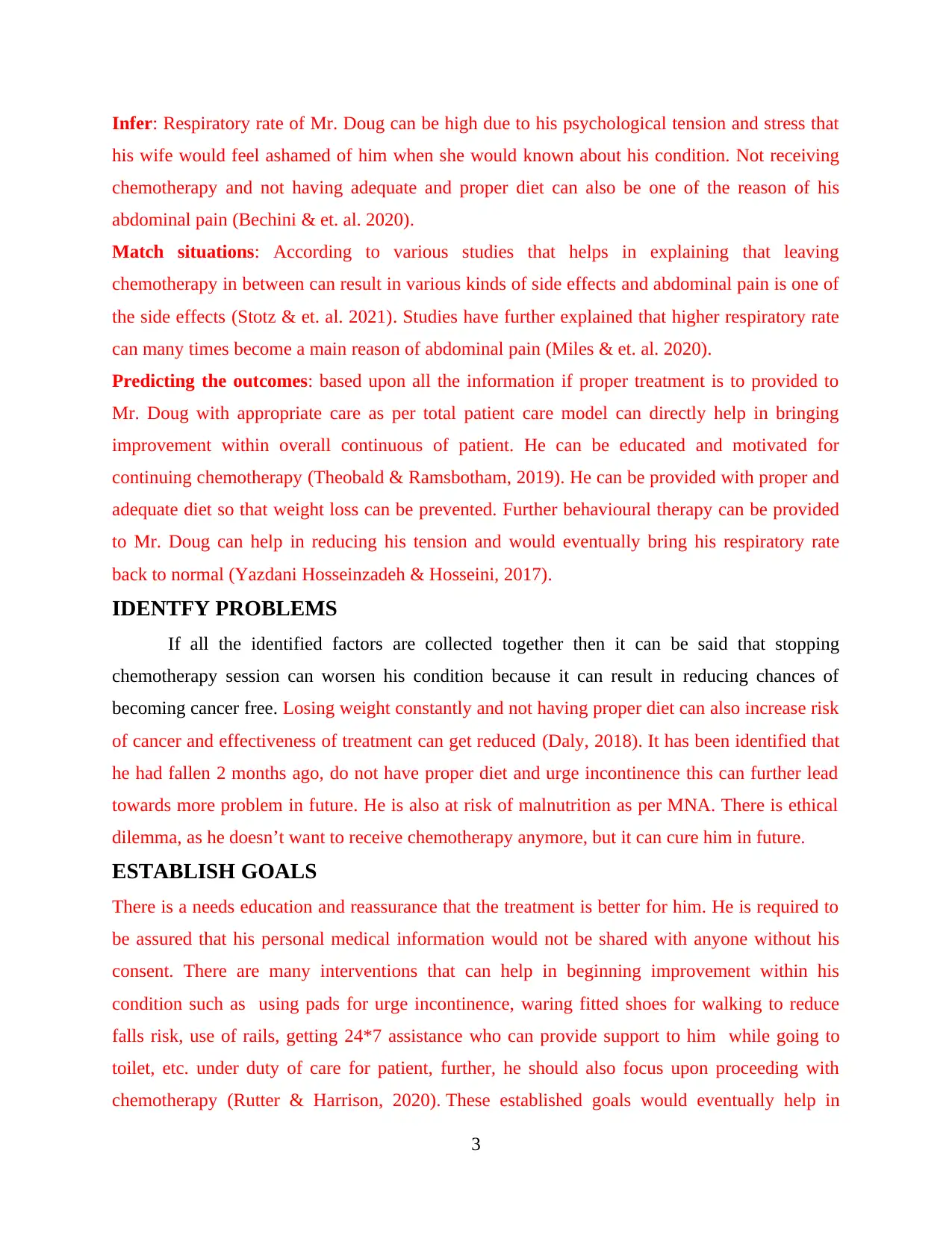
Infer: Respiratory rate of Mr. Doug can be high due to his psychological tension and stress that
his wife would feel ashamed of him when she would known about his condition. Not receiving
chemotherapy and not having adequate and proper diet can also be one of the reason of his
abdominal pain (Bechini & et. al. 2020).
Match situations: According to various studies that helps in explaining that leaving
chemotherapy in between can result in various kinds of side effects and abdominal pain is one of
the side effects (Stotz & et. al. 2021). Studies have further explained that higher respiratory rate
can many times become a main reason of abdominal pain (Miles & et. al. 2020).
Predicting the outcomes: based upon all the information if proper treatment is to provided to
Mr. Doug with appropriate care as per total patient care model can directly help in bringing
improvement within overall continuous of patient. He can be educated and motivated for
continuing chemotherapy (Theobald & Ramsbotham, 2019). He can be provided with proper and
adequate diet so that weight loss can be prevented. Further behavioural therapy can be provided
to Mr. Doug can help in reducing his tension and would eventually bring his respiratory rate
back to normal (Yazdani Hosseinzadeh & Hosseini, 2017).
IDENTFY PROBLEMS
If all the identified factors are collected together then it can be said that stopping
chemotherapy session can worsen his condition because it can result in reducing chances of
becoming cancer free. Losing weight constantly and not having proper diet can also increase risk
of cancer and effectiveness of treatment can get reduced (Daly, 2018). It has been identified that
he had fallen 2 months ago, do not have proper diet and urge incontinence this can further lead
towards more problem in future. He is also at risk of malnutrition as per MNA. There is ethical
dilemma, as he doesn’t want to receive chemotherapy anymore, but it can cure him in future.
ESTABLISH GOALS
There is a needs education and reassurance that the treatment is better for him. He is required to
be assured that his personal medical information would not be shared with anyone without his
consent. There are many interventions that can help in beginning improvement within his
condition such as using pads for urge incontinence, waring fitted shoes for walking to reduce
falls risk, use of rails, getting 24*7 assistance who can provide support to him while going to
toilet, etc. under duty of care for patient, further, he should also focus upon proceeding with
chemotherapy (Rutter & Harrison, 2020). These established goals would eventually help in
3
his wife would feel ashamed of him when she would known about his condition. Not receiving
chemotherapy and not having adequate and proper diet can also be one of the reason of his
abdominal pain (Bechini & et. al. 2020).
Match situations: According to various studies that helps in explaining that leaving
chemotherapy in between can result in various kinds of side effects and abdominal pain is one of
the side effects (Stotz & et. al. 2021). Studies have further explained that higher respiratory rate
can many times become a main reason of abdominal pain (Miles & et. al. 2020).
Predicting the outcomes: based upon all the information if proper treatment is to provided to
Mr. Doug with appropriate care as per total patient care model can directly help in bringing
improvement within overall continuous of patient. He can be educated and motivated for
continuing chemotherapy (Theobald & Ramsbotham, 2019). He can be provided with proper and
adequate diet so that weight loss can be prevented. Further behavioural therapy can be provided
to Mr. Doug can help in reducing his tension and would eventually bring his respiratory rate
back to normal (Yazdani Hosseinzadeh & Hosseini, 2017).
IDENTFY PROBLEMS
If all the identified factors are collected together then it can be said that stopping
chemotherapy session can worsen his condition because it can result in reducing chances of
becoming cancer free. Losing weight constantly and not having proper diet can also increase risk
of cancer and effectiveness of treatment can get reduced (Daly, 2018). It has been identified that
he had fallen 2 months ago, do not have proper diet and urge incontinence this can further lead
towards more problem in future. He is also at risk of malnutrition as per MNA. There is ethical
dilemma, as he doesn’t want to receive chemotherapy anymore, but it can cure him in future.
ESTABLISH GOALS
There is a needs education and reassurance that the treatment is better for him. He is required to
be assured that his personal medical information would not be shared with anyone without his
consent. There are many interventions that can help in beginning improvement within his
condition such as using pads for urge incontinence, waring fitted shoes for walking to reduce
falls risk, use of rails, getting 24*7 assistance who can provide support to him while going to
toilet, etc. under duty of care for patient, further, he should also focus upon proceeding with
chemotherapy (Rutter & Harrison, 2020). These established goals would eventually help in
3
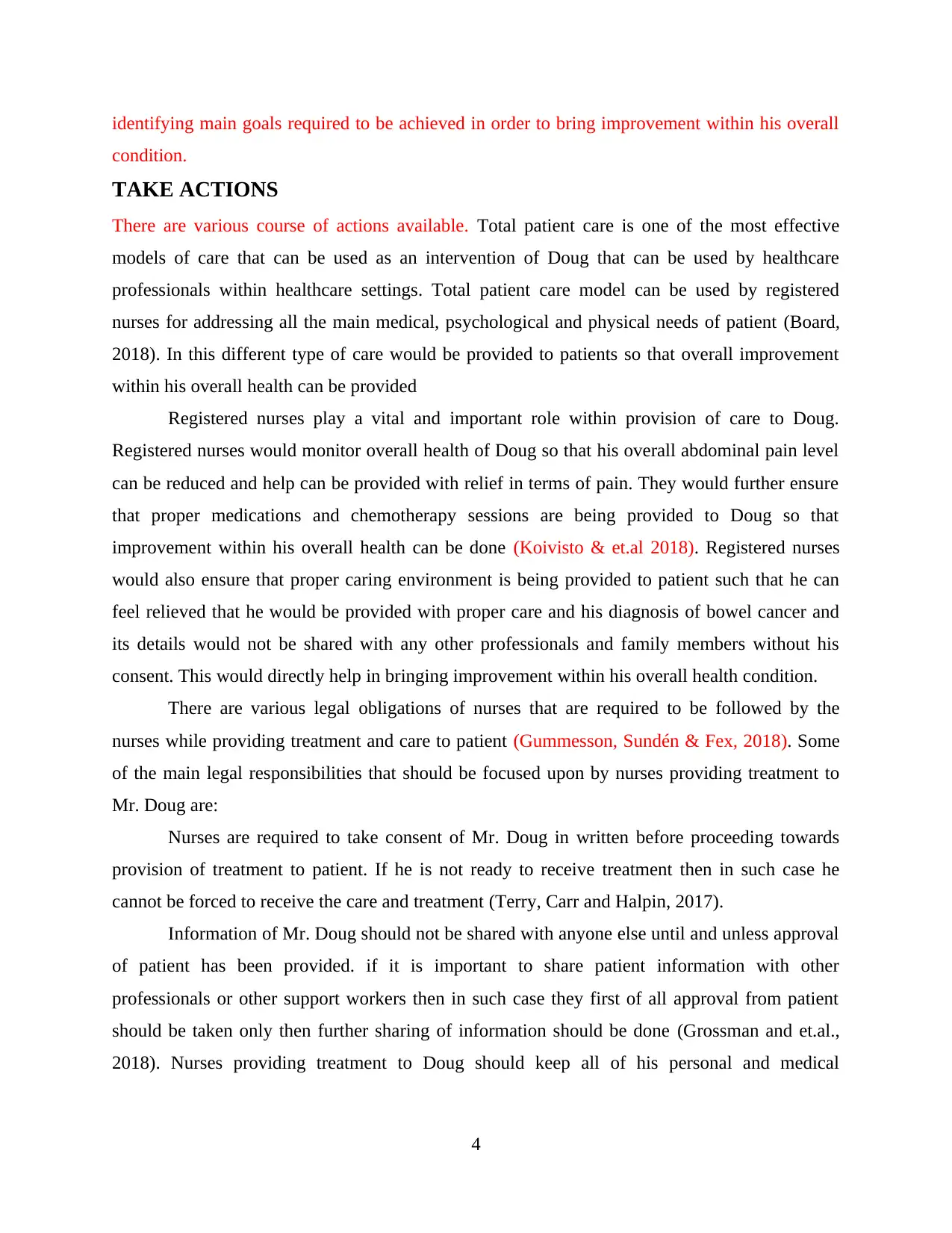
identifying main goals required to be achieved in order to bring improvement within his overall
condition.
TAKE ACTIONS
There are various course of actions available. Total patient care is one of the most effective
models of care that can be used as an intervention of Doug that can be used by healthcare
professionals within healthcare settings. Total patient care model can be used by registered
nurses for addressing all the main medical, psychological and physical needs of patient (Board,
2018). In this different type of care would be provided to patients so that overall improvement
within his overall health can be provided
Registered nurses play a vital and important role within provision of care to Doug.
Registered nurses would monitor overall health of Doug so that his overall abdominal pain level
can be reduced and help can be provided with relief in terms of pain. They would further ensure
that proper medications and chemotherapy sessions are being provided to Doug so that
improvement within his overall health can be done (Koivisto & et.al 2018). Registered nurses
would also ensure that proper caring environment is being provided to patient such that he can
feel relieved that he would be provided with proper care and his diagnosis of bowel cancer and
its details would not be shared with any other professionals and family members without his
consent. This would directly help in bringing improvement within his overall health condition.
There are various legal obligations of nurses that are required to be followed by the
nurses while providing treatment and care to patient (Gummesson, Sundén & Fex, 2018). Some
of the main legal responsibilities that should be focused upon by nurses providing treatment to
Mr. Doug are:
Nurses are required to take consent of Mr. Doug in written before proceeding towards
provision of treatment to patient. If he is not ready to receive treatment then in such case he
cannot be forced to receive the care and treatment (Terry, Carr and Halpin, 2017).
Information of Mr. Doug should not be shared with anyone else until and unless approval
of patient has been provided. if it is important to share patient information with other
professionals or other support workers then in such case they first of all approval from patient
should be taken only then further sharing of information should be done (Grossman and et.al.,
2018). Nurses providing treatment to Doug should keep all of his personal and medical
4
condition.
TAKE ACTIONS
There are various course of actions available. Total patient care is one of the most effective
models of care that can be used as an intervention of Doug that can be used by healthcare
professionals within healthcare settings. Total patient care model can be used by registered
nurses for addressing all the main medical, psychological and physical needs of patient (Board,
2018). In this different type of care would be provided to patients so that overall improvement
within his overall health can be provided
Registered nurses play a vital and important role within provision of care to Doug.
Registered nurses would monitor overall health of Doug so that his overall abdominal pain level
can be reduced and help can be provided with relief in terms of pain. They would further ensure
that proper medications and chemotherapy sessions are being provided to Doug so that
improvement within his overall health can be done (Koivisto & et.al 2018). Registered nurses
would also ensure that proper caring environment is being provided to patient such that he can
feel relieved that he would be provided with proper care and his diagnosis of bowel cancer and
its details would not be shared with any other professionals and family members without his
consent. This would directly help in bringing improvement within his overall health condition.
There are various legal obligations of nurses that are required to be followed by the
nurses while providing treatment and care to patient (Gummesson, Sundén & Fex, 2018). Some
of the main legal responsibilities that should be focused upon by nurses providing treatment to
Mr. Doug are:
Nurses are required to take consent of Mr. Doug in written before proceeding towards
provision of treatment to patient. If he is not ready to receive treatment then in such case he
cannot be forced to receive the care and treatment (Terry, Carr and Halpin, 2017).
Information of Mr. Doug should not be shared with anyone else until and unless approval
of patient has been provided. if it is important to share patient information with other
professionals or other support workers then in such case they first of all approval from patient
should be taken only then further sharing of information should be done (Grossman and et.al.,
2018). Nurses providing treatment to Doug should keep all of his personal and medical
4
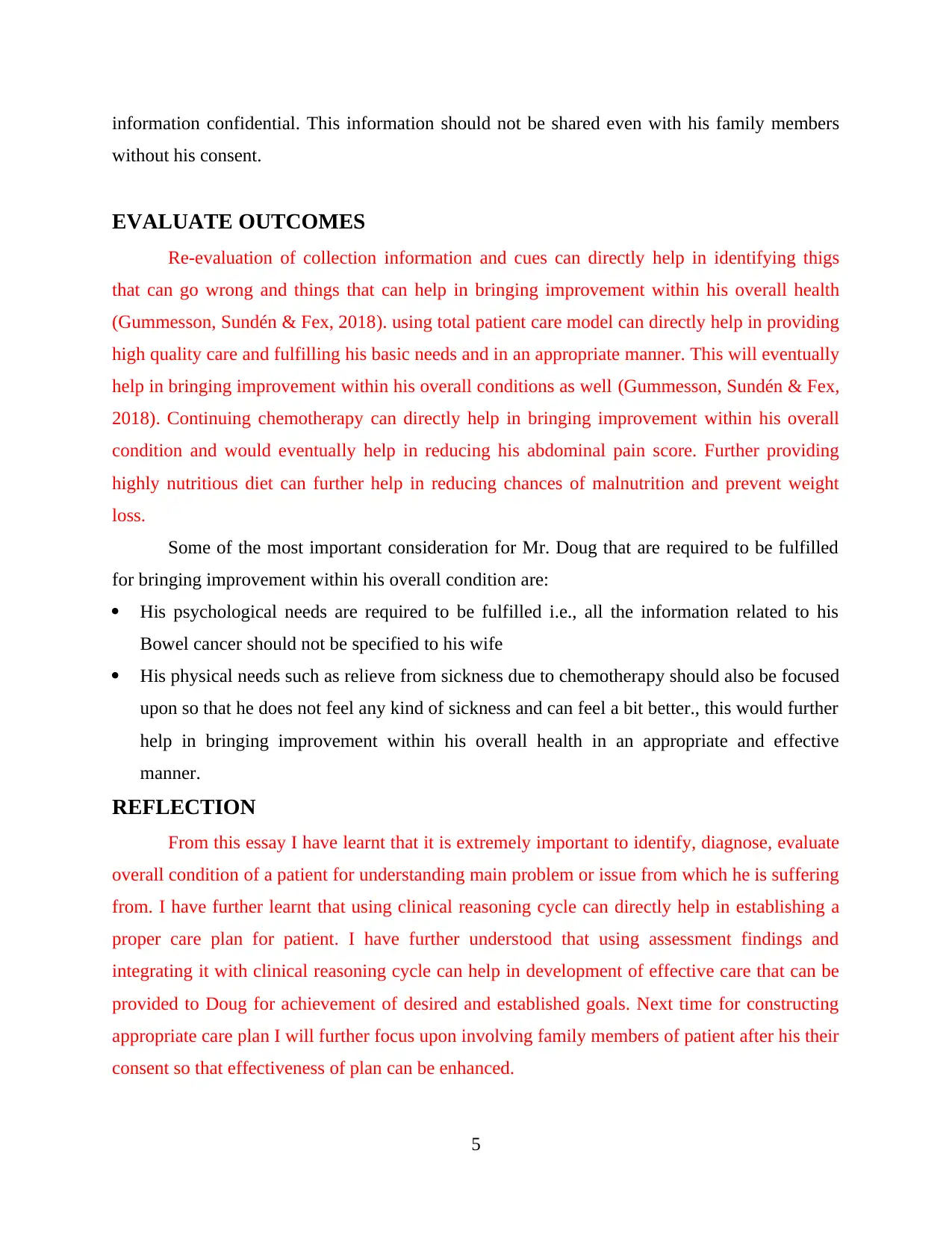
information confidential. This information should not be shared even with his family members
without his consent.
EVALUATE OUTCOMES
Re-evaluation of collection information and cues can directly help in identifying thigs
that can go wrong and things that can help in bringing improvement within his overall health
(Gummesson, Sundén & Fex, 2018). using total patient care model can directly help in providing
high quality care and fulfilling his basic needs and in an appropriate manner. This will eventually
help in bringing improvement within his overall conditions as well (Gummesson, Sundén & Fex,
2018). Continuing chemotherapy can directly help in bringing improvement within his overall
condition and would eventually help in reducing his abdominal pain score. Further providing
highly nutritious diet can further help in reducing chances of malnutrition and prevent weight
loss.
Some of the most important consideration for Mr. Doug that are required to be fulfilled
for bringing improvement within his overall condition are:
His psychological needs are required to be fulfilled i.e., all the information related to his
Bowel cancer should not be specified to his wife
His physical needs such as relieve from sickness due to chemotherapy should also be focused
upon so that he does not feel any kind of sickness and can feel a bit better., this would further
help in bringing improvement within his overall health in an appropriate and effective
manner.
REFLECTION
From this essay I have learnt that it is extremely important to identify, diagnose, evaluate
overall condition of a patient for understanding main problem or issue from which he is suffering
from. I have further learnt that using clinical reasoning cycle can directly help in establishing a
proper care plan for patient. I have further understood that using assessment findings and
integrating it with clinical reasoning cycle can help in development of effective care that can be
provided to Doug for achievement of desired and established goals. Next time for constructing
appropriate care plan I will further focus upon involving family members of patient after his their
consent so that effectiveness of plan can be enhanced.
5
without his consent.
EVALUATE OUTCOMES
Re-evaluation of collection information and cues can directly help in identifying thigs
that can go wrong and things that can help in bringing improvement within his overall health
(Gummesson, Sundén & Fex, 2018). using total patient care model can directly help in providing
high quality care and fulfilling his basic needs and in an appropriate manner. This will eventually
help in bringing improvement within his overall conditions as well (Gummesson, Sundén & Fex,
2018). Continuing chemotherapy can directly help in bringing improvement within his overall
condition and would eventually help in reducing his abdominal pain score. Further providing
highly nutritious diet can further help in reducing chances of malnutrition and prevent weight
loss.
Some of the most important consideration for Mr. Doug that are required to be fulfilled
for bringing improvement within his overall condition are:
His psychological needs are required to be fulfilled i.e., all the information related to his
Bowel cancer should not be specified to his wife
His physical needs such as relieve from sickness due to chemotherapy should also be focused
upon so that he does not feel any kind of sickness and can feel a bit better., this would further
help in bringing improvement within his overall health in an appropriate and effective
manner.
REFLECTION
From this essay I have learnt that it is extremely important to identify, diagnose, evaluate
overall condition of a patient for understanding main problem or issue from which he is suffering
from. I have further learnt that using clinical reasoning cycle can directly help in establishing a
proper care plan for patient. I have further understood that using assessment findings and
integrating it with clinical reasoning cycle can help in development of effective care that can be
provided to Doug for achievement of desired and established goals. Next time for constructing
appropriate care plan I will further focus upon involving family members of patient after his their
consent so that effectiveness of plan can be enhanced.
5
Paraphrase This Document
Need a fresh take? Get an instant paraphrase of this document with our AI Paraphraser
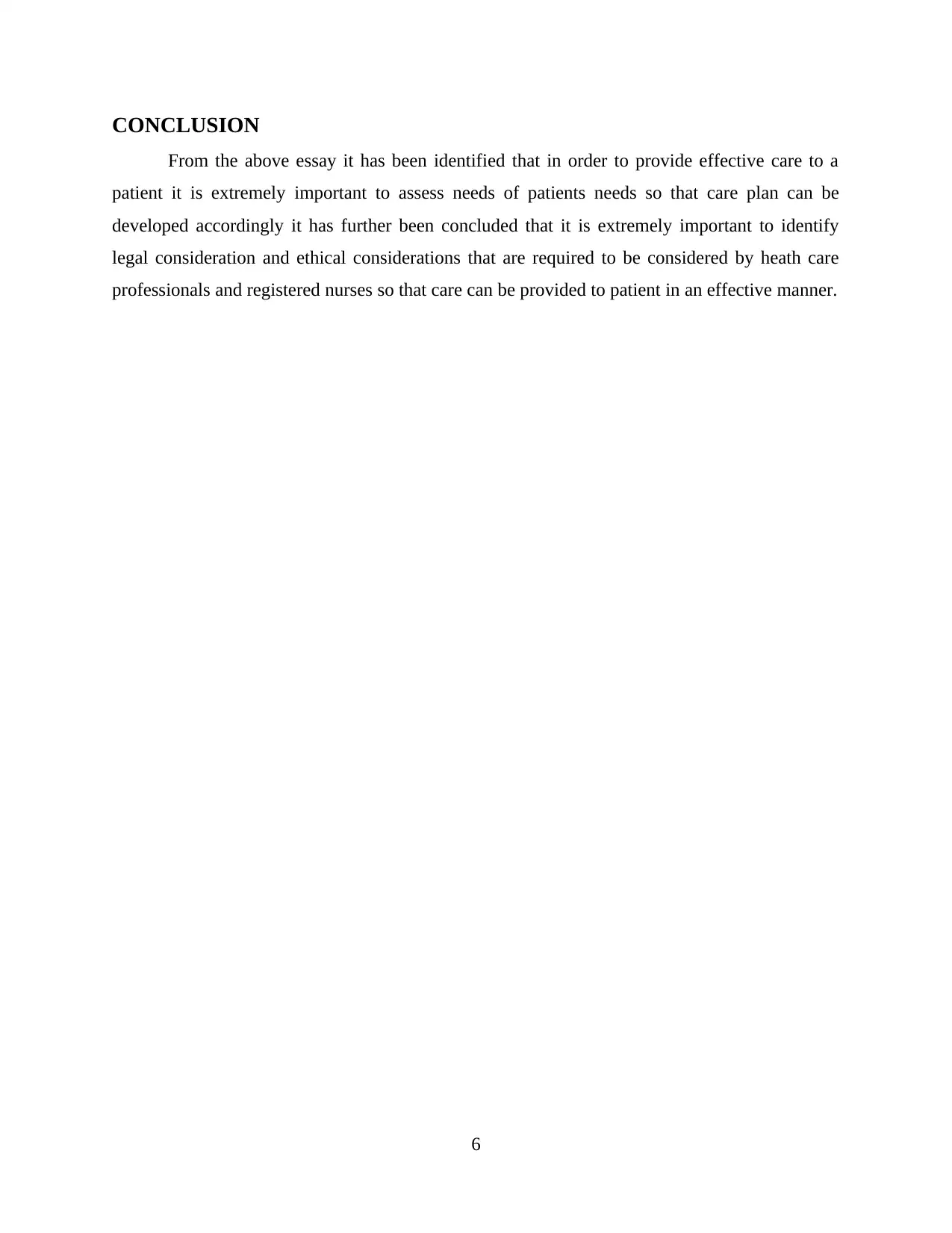
CONCLUSION
From the above essay it has been identified that in order to provide effective care to a
patient it is extremely important to assess needs of patients needs so that care plan can be
developed accordingly it has further been concluded that it is extremely important to identify
legal consideration and ethical considerations that are required to be considered by heath care
professionals and registered nurses so that care can be provided to patient in an effective manner.
6
From the above essay it has been identified that in order to provide effective care to a
patient it is extremely important to assess needs of patients needs so that care plan can be
developed accordingly it has further been concluded that it is extremely important to identify
legal consideration and ethical considerations that are required to be considered by heath care
professionals and registered nurses so that care can be provided to patient in an effective manner.
6
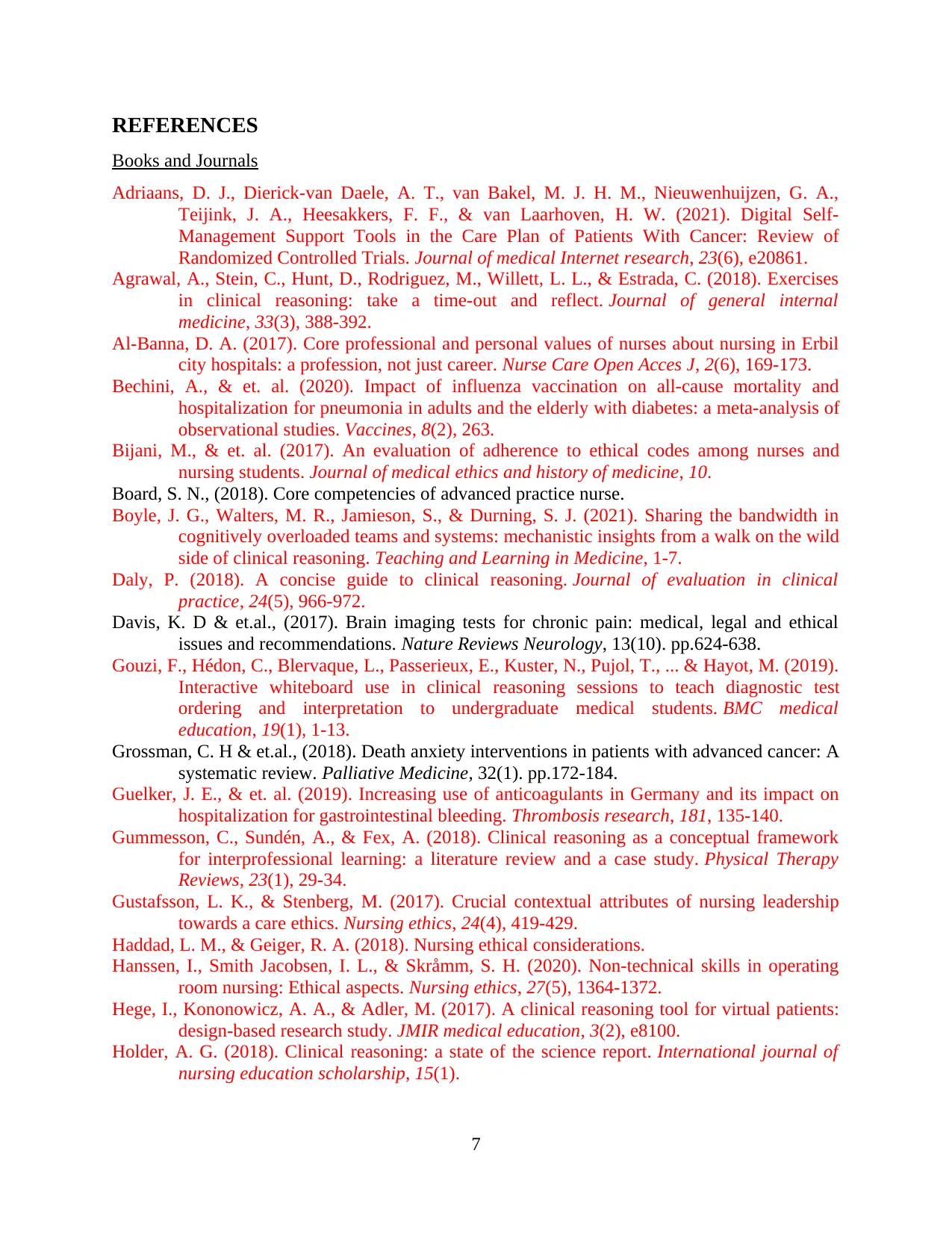
REFERENCES
Books and Journals
Adriaans, D. J., Dierick-van Daele, A. T., van Bakel, M. J. H. M., Nieuwenhuijzen, G. A.,
Teijink, J. A., Heesakkers, F. F., & van Laarhoven, H. W. (2021). Digital Self-
Management Support Tools in the Care Plan of Patients With Cancer: Review of
Randomized Controlled Trials. Journal of medical Internet research, 23(6), e20861.
Agrawal, A., Stein, C., Hunt, D., Rodriguez, M., Willett, L. L., & Estrada, C. (2018). Exercises
in clinical reasoning: take a time-out and reflect. Journal of general internal
medicine, 33(3), 388-392.
Al-Banna, D. A. (2017). Core professional and personal values of nurses about nursing in Erbil
city hospitals: a profession, not just career. Nurse Care Open Acces J, 2(6), 169-173.
Bechini, A., & et. al. (2020). Impact of influenza vaccination on all-cause mortality and
hospitalization for pneumonia in adults and the elderly with diabetes: a meta-analysis of
observational studies. Vaccines, 8(2), 263.
Bijani, M., & et. al. (2017). An evaluation of adherence to ethical codes among nurses and
nursing students. Journal of medical ethics and history of medicine, 10.
Board, S. N., (2018). Core competencies of advanced practice nurse.
Boyle, J. G., Walters, M. R., Jamieson, S., & Durning, S. J. (2021). Sharing the bandwidth in
cognitively overloaded teams and systems: mechanistic insights from a walk on the wild
side of clinical reasoning. Teaching and Learning in Medicine, 1-7.
Daly, P. (2018). A concise guide to clinical reasoning. Journal of evaluation in clinical
practice, 24(5), 966-972.
Davis, K. D & et.al., (2017). Brain imaging tests for chronic pain: medical, legal and ethical
issues and recommendations. Nature Reviews Neurology, 13(10). pp.624-638.
Gouzi, F., Hédon, C., Blervaque, L., Passerieux, E., Kuster, N., Pujol, T., ... & Hayot, M. (2019).
Interactive whiteboard use in clinical reasoning sessions to teach diagnostic test
ordering and interpretation to undergraduate medical students. BMC medical
education, 19(1), 1-13.
Grossman, C. H & et.al., (2018). Death anxiety interventions in patients with advanced cancer: A
systematic review. Palliative Medicine, 32(1). pp.172-184.
Guelker, J. E., & et. al. (2019). Increasing use of anticoagulants in Germany and its impact on
hospitalization for gastrointestinal bleeding. Thrombosis research, 181, 135-140.
Gummesson, C., Sundén, A., & Fex, A. (2018). Clinical reasoning as a conceptual framework
for interprofessional learning: a literature review and a case study. Physical Therapy
Reviews, 23(1), 29-34.
Gustafsson, L. K., & Stenberg, M. (2017). Crucial contextual attributes of nursing leadership
towards a care ethics. Nursing ethics, 24(4), 419-429.
Haddad, L. M., & Geiger, R. A. (2018). Nursing ethical considerations.
Hanssen, I., Smith Jacobsen, I. L., & Skråmm, S. H. (2020). Non-technical skills in operating
room nursing: Ethical aspects. Nursing ethics, 27(5), 1364-1372.
Hege, I., Kononowicz, A. A., & Adler, M. (2017). A clinical reasoning tool for virtual patients:
design-based research study. JMIR medical education, 3(2), e8100.
Holder, A. G. (2018). Clinical reasoning: a state of the science report. International journal of
nursing education scholarship, 15(1).
7
Books and Journals
Adriaans, D. J., Dierick-van Daele, A. T., van Bakel, M. J. H. M., Nieuwenhuijzen, G. A.,
Teijink, J. A., Heesakkers, F. F., & van Laarhoven, H. W. (2021). Digital Self-
Management Support Tools in the Care Plan of Patients With Cancer: Review of
Randomized Controlled Trials. Journal of medical Internet research, 23(6), e20861.
Agrawal, A., Stein, C., Hunt, D., Rodriguez, M., Willett, L. L., & Estrada, C. (2018). Exercises
in clinical reasoning: take a time-out and reflect. Journal of general internal
medicine, 33(3), 388-392.
Al-Banna, D. A. (2017). Core professional and personal values of nurses about nursing in Erbil
city hospitals: a profession, not just career. Nurse Care Open Acces J, 2(6), 169-173.
Bechini, A., & et. al. (2020). Impact of influenza vaccination on all-cause mortality and
hospitalization for pneumonia in adults and the elderly with diabetes: a meta-analysis of
observational studies. Vaccines, 8(2), 263.
Bijani, M., & et. al. (2017). An evaluation of adherence to ethical codes among nurses and
nursing students. Journal of medical ethics and history of medicine, 10.
Board, S. N., (2018). Core competencies of advanced practice nurse.
Boyle, J. G., Walters, M. R., Jamieson, S., & Durning, S. J. (2021). Sharing the bandwidth in
cognitively overloaded teams and systems: mechanistic insights from a walk on the wild
side of clinical reasoning. Teaching and Learning in Medicine, 1-7.
Daly, P. (2018). A concise guide to clinical reasoning. Journal of evaluation in clinical
practice, 24(5), 966-972.
Davis, K. D & et.al., (2017). Brain imaging tests for chronic pain: medical, legal and ethical
issues and recommendations. Nature Reviews Neurology, 13(10). pp.624-638.
Gouzi, F., Hédon, C., Blervaque, L., Passerieux, E., Kuster, N., Pujol, T., ... & Hayot, M. (2019).
Interactive whiteboard use in clinical reasoning sessions to teach diagnostic test
ordering and interpretation to undergraduate medical students. BMC medical
education, 19(1), 1-13.
Grossman, C. H & et.al., (2018). Death anxiety interventions in patients with advanced cancer: A
systematic review. Palliative Medicine, 32(1). pp.172-184.
Guelker, J. E., & et. al. (2019). Increasing use of anticoagulants in Germany and its impact on
hospitalization for gastrointestinal bleeding. Thrombosis research, 181, 135-140.
Gummesson, C., Sundén, A., & Fex, A. (2018). Clinical reasoning as a conceptual framework
for interprofessional learning: a literature review and a case study. Physical Therapy
Reviews, 23(1), 29-34.
Gustafsson, L. K., & Stenberg, M. (2017). Crucial contextual attributes of nursing leadership
towards a care ethics. Nursing ethics, 24(4), 419-429.
Haddad, L. M., & Geiger, R. A. (2018). Nursing ethical considerations.
Hanssen, I., Smith Jacobsen, I. L., & Skråmm, S. H. (2020). Non-technical skills in operating
room nursing: Ethical aspects. Nursing ethics, 27(5), 1364-1372.
Hege, I., Kononowicz, A. A., & Adler, M. (2017). A clinical reasoning tool for virtual patients:
design-based research study. JMIR medical education, 3(2), e8100.
Holder, A. G. (2018). Clinical reasoning: a state of the science report. International journal of
nursing education scholarship, 15(1).
7
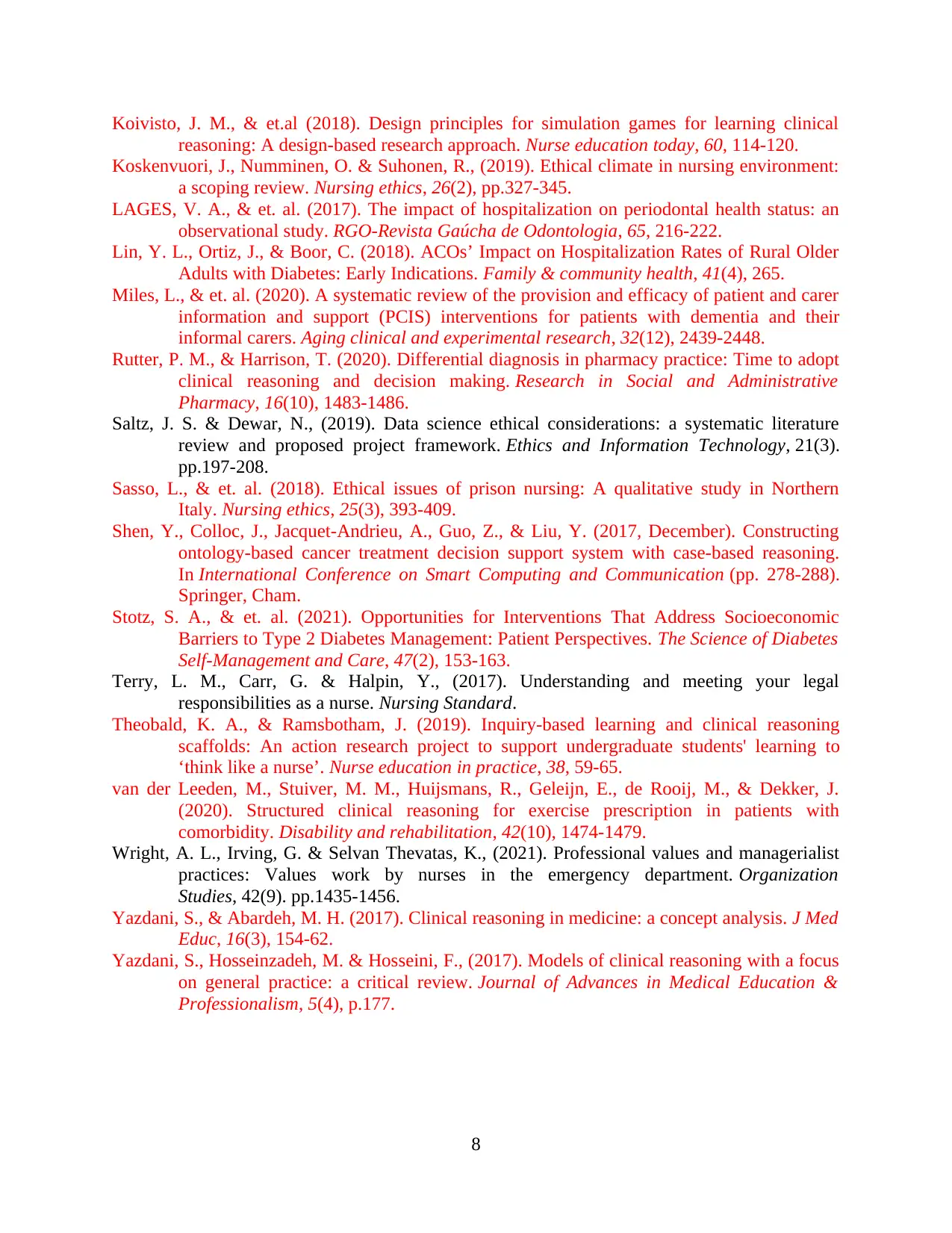
Koivisto, J. M., & et.al (2018). Design principles for simulation games for learning clinical
reasoning: A design-based research approach. Nurse education today, 60, 114-120.
Koskenvuori, J., Numminen, O. & Suhonen, R., (2019). Ethical climate in nursing environment:
a scoping review. Nursing ethics, 26(2), pp.327-345.
LAGES, V. A., & et. al. (2017). The impact of hospitalization on periodontal health status: an
observational study. RGO-Revista Gaúcha de Odontologia, 65, 216-222.
Lin, Y. L., Ortiz, J., & Boor, C. (2018). ACOs’ Impact on Hospitalization Rates of Rural Older
Adults with Diabetes: Early Indications. Family & community health, 41(4), 265.
Miles, L., & et. al. (2020). A systematic review of the provision and efficacy of patient and carer
information and support (PCIS) interventions for patients with dementia and their
informal carers. Aging clinical and experimental research, 32(12), 2439-2448.
Rutter, P. M., & Harrison, T. (2020). Differential diagnosis in pharmacy practice: Time to adopt
clinical reasoning and decision making. Research in Social and Administrative
Pharmacy, 16(10), 1483-1486.
Saltz, J. S. & Dewar, N., (2019). Data science ethical considerations: a systematic literature
review and proposed project framework. Ethics and Information Technology, 21(3).
pp.197-208.
Sasso, L., & et. al. (2018). Ethical issues of prison nursing: A qualitative study in Northern
Italy. Nursing ethics, 25(3), 393-409.
Shen, Y., Colloc, J., Jacquet-Andrieu, A., Guo, Z., & Liu, Y. (2017, December). Constructing
ontology-based cancer treatment decision support system with case-based reasoning.
In International Conference on Smart Computing and Communication (pp. 278-288).
Springer, Cham.
Stotz, S. A., & et. al. (2021). Opportunities for Interventions That Address Socioeconomic
Barriers to Type 2 Diabetes Management: Patient Perspectives. The Science of Diabetes
Self-Management and Care, 47(2), 153-163.
Terry, L. M., Carr, G. & Halpin, Y., (2017). Understanding and meeting your legal
responsibilities as a nurse. Nursing Standard.
Theobald, K. A., & Ramsbotham, J. (2019). Inquiry-based learning and clinical reasoning
scaffolds: An action research project to support undergraduate students' learning to
‘think like a nurse’. Nurse education in practice, 38, 59-65.
van der Leeden, M., Stuiver, M. M., Huijsmans, R., Geleijn, E., de Rooij, M., & Dekker, J.
(2020). Structured clinical reasoning for exercise prescription in patients with
comorbidity. Disability and rehabilitation, 42(10), 1474-1479.
Wright, A. L., Irving, G. & Selvan Thevatas, K., (2021). Professional values and managerialist
practices: Values work by nurses in the emergency department. Organization
Studies, 42(9). pp.1435-1456.
Yazdani, S., & Abardeh, M. H. (2017). Clinical reasoning in medicine: a concept analysis. J Med
Educ, 16(3), 154-62.
Yazdani, S., Hosseinzadeh, M. & Hosseini, F., (2017). Models of clinical reasoning with a focus
on general practice: a critical review. Journal of Advances in Medical Education &
Professionalism, 5(4), p.177.
8
reasoning: A design-based research approach. Nurse education today, 60, 114-120.
Koskenvuori, J., Numminen, O. & Suhonen, R., (2019). Ethical climate in nursing environment:
a scoping review. Nursing ethics, 26(2), pp.327-345.
LAGES, V. A., & et. al. (2017). The impact of hospitalization on periodontal health status: an
observational study. RGO-Revista Gaúcha de Odontologia, 65, 216-222.
Lin, Y. L., Ortiz, J., & Boor, C. (2018). ACOs’ Impact on Hospitalization Rates of Rural Older
Adults with Diabetes: Early Indications. Family & community health, 41(4), 265.
Miles, L., & et. al. (2020). A systematic review of the provision and efficacy of patient and carer
information and support (PCIS) interventions for patients with dementia and their
informal carers. Aging clinical and experimental research, 32(12), 2439-2448.
Rutter, P. M., & Harrison, T. (2020). Differential diagnosis in pharmacy practice: Time to adopt
clinical reasoning and decision making. Research in Social and Administrative
Pharmacy, 16(10), 1483-1486.
Saltz, J. S. & Dewar, N., (2019). Data science ethical considerations: a systematic literature
review and proposed project framework. Ethics and Information Technology, 21(3).
pp.197-208.
Sasso, L., & et. al. (2018). Ethical issues of prison nursing: A qualitative study in Northern
Italy. Nursing ethics, 25(3), 393-409.
Shen, Y., Colloc, J., Jacquet-Andrieu, A., Guo, Z., & Liu, Y. (2017, December). Constructing
ontology-based cancer treatment decision support system with case-based reasoning.
In International Conference on Smart Computing and Communication (pp. 278-288).
Springer, Cham.
Stotz, S. A., & et. al. (2021). Opportunities for Interventions That Address Socioeconomic
Barriers to Type 2 Diabetes Management: Patient Perspectives. The Science of Diabetes
Self-Management and Care, 47(2), 153-163.
Terry, L. M., Carr, G. & Halpin, Y., (2017). Understanding and meeting your legal
responsibilities as a nurse. Nursing Standard.
Theobald, K. A., & Ramsbotham, J. (2019). Inquiry-based learning and clinical reasoning
scaffolds: An action research project to support undergraduate students' learning to
‘think like a nurse’. Nurse education in practice, 38, 59-65.
van der Leeden, M., Stuiver, M. M., Huijsmans, R., Geleijn, E., de Rooij, M., & Dekker, J.
(2020). Structured clinical reasoning for exercise prescription in patients with
comorbidity. Disability and rehabilitation, 42(10), 1474-1479.
Wright, A. L., Irving, G. & Selvan Thevatas, K., (2021). Professional values and managerialist
practices: Values work by nurses in the emergency department. Organization
Studies, 42(9). pp.1435-1456.
Yazdani, S., & Abardeh, M. H. (2017). Clinical reasoning in medicine: a concept analysis. J Med
Educ, 16(3), 154-62.
Yazdani, S., Hosseinzadeh, M. & Hosseini, F., (2017). Models of clinical reasoning with a focus
on general practice: a critical review. Journal of Advances in Medical Education &
Professionalism, 5(4), p.177.
8
1 out of 10
Related Documents
Your All-in-One AI-Powered Toolkit for Academic Success.
+13062052269
info@desklib.com
Available 24*7 on WhatsApp / Email
![[object Object]](/_next/static/media/star-bottom.7253800d.svg)
Unlock your academic potential
© 2024 | Zucol Services PVT LTD | All rights reserved.





